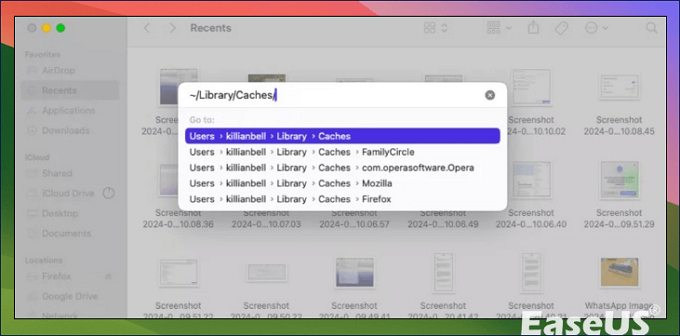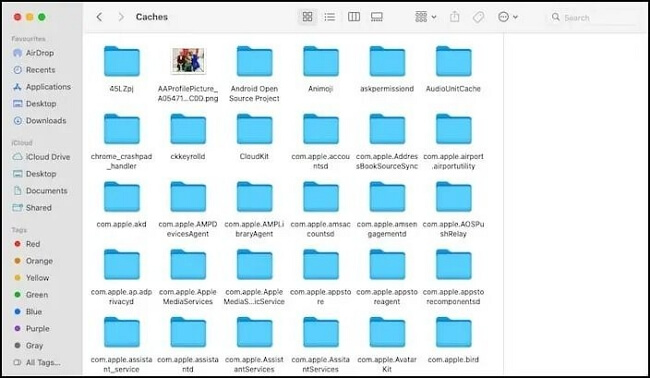- Video Recovery
- SD Card Recovery
- Recycle Bin Recovery
- Recover Data from USB
- Recover Deleted Emails
- Hard Drive Not Showing Up in Windows
- Recover Unsaved Word Documents
- Recover Deleted Files in Windows 10
- Recover Files from Virus Infected Hard Drive
- Best Free Photo Recovery Software
- Recover Files from Formatted Hard Drive
In this article, you'll learn how to clear Temp files on Mac to enhance its speed and storage capacity. Temporary files are data or files created while using applications and browsing the Internet on a Mac. When a Mac is used, temporary files are generated to ensure the device's performance.
These temporary files typically include caches from apps, system files, web browsers, old system logs, and intermediate document versions. Some of these files help speed up browsing without slowing down Mac loading times, while outdated ones can occupy space and negatively impact your Mac's performance.
How to Clear Temp Files on Mac
When you use applications and surf the web on your Mac, files, also known as temp files, are generated. These files can accumulate over time, occupying some of your hard drive space.
Fix 1. Clean App Temp Files in Finder
To clean application temporary files in Finder on your Mac, follow these simple steps:
Step 1. Start by clicking your dock's "Finder" icon to open a Finder window.
Step 2. Head to the top of your screen. Select "Go" in the Finder menu bar. Next, choose "Go to Folder..." from the choices.
Step 3. A dialog box will pop up; enter ~/Library/Caches. Press the "Enter" key.

Step 4. You will see a list of folders for different applications. Open the relevant application's folder and select the temporary files you want to delete.
Step 5. Drag them over to the "Trash can" symbol on your dock.
Step 6. Right-click on the Trash can. Pick "Empty Trash" to remove the files.
Fix 2. Empty the Cache in Safari
Step 1. Open Safari, then click "Safari" > "Settings" in the menu bar.
Step 2. Select the "Privacy" tab, then click "Manage Website Data".

Step 3. Click the "Remove All" button to clear cache files for all websites, then click "Remove Now" to confirm.

Is It Safe to Delete Cache Files on Mac [macOS Recovery]
Is the Cache folder taking too much space on your MacBook? Then follow this easy guide on how to get rid of the cache folder. Read more >>
Fix 3. Clear Browser Temporary Files
Google Chrome tends to slow down after some time. You can speed it up by clearing its cache files. Here's a simple guide to get it done:
Step 1. In Chrome, click the "three dots" at the corner to access the menu.
Step 2. Then, choose "Settings". Navigate to "Privacy and Security".

Step 3. Select" Clear browsing data," then check the "Cookies and other site data" & Cached Image and file" boxes.
Step 4. Click the "Clear Data" button.

If you've found this guide helpful, consider sharing it with your circle on media to help them delete temporary files on a Mac.
Windows users operating on a Mac environment may need to clear Temp files for several reasons:
- Performance Improvement: Accumulated Temp files can slow down system performance. Clearing them can help maintain the Mac's optimal operation.
- Freeing Up Space: Temp files can take up significant storage space. Regular cleaning frees up space for other important files and applications.
- System Stability: Excessive Temp files can lead to system errors and crashes. Clearing these files can contribute to a more stable system environment.
- Security: Some Temp files may contain sensitive information. Removing them helps protect privacy and secure data against unauthorized access.
- Troubleshooting: Clearing Temp files can resolve issues related to software conflicts or corrupted files, aiding in troubleshooting various system problems
[Bonus Tip] How to Recover Deleted Files on Mac
Losing files accidentally while cleaning out files on your Mac can be pretty frustrating. Fortunately, tools like EasеUS Data Recovery Wizard for Mac can help in situations. This reliable software is designed to recover lost macOS data from scenarios, including deletions.
- If you've misplaced documents, photos, videos, or emails, this software is tailored to assist in retrieving them.
- It enables data recovery from storage devices such as drives, solid-state drives, USB drives, and memory cards.
The tool's dependability is evident through its recovery rate and ability to restore files from Mac that won't boot. If you have emptied your Trash Bin or experienced a system crash, EasеUS Data Recovery Wizard for Mac can be a lifesaver.
Step 1. Select the location to scan
Launch EaseUS Data Recovery Wizard for Mac and choose the hard drive, SSD, SD card, USB flash drive, or TF card where you lost data. Click "Search for lost files" to start scanning.

Step 2. Filter lost Mac data
The software will automatically scan for lost data on MacBook/iMac. When the scan completes, filter wanted data through the "Type" and "Path" buttons.

Step 3. Recover lost data or files
Double-click a file to preview it. Then, click the "Recover" button to restore the lost data to another place.

Summary
If you own a Mac, this post has illustrated how to clear temp files hassle-free. Just follow the solution above, and if you lose any important data in the process, we recommend you use EaseUS Data Recovery Wizard for Mac to restore them in a minute.
How to Clear Temp Files on Mac FAQs
In this section, you'll learn more about how to clear temp files on a Mac.
1. How do I delete temp files on Mac?
To clear out files, on a Mac, you can access the ~/Library/Caches folder using Finder, which is where most temporary files related to apps are kept.
- Once you have Finder open, click on "Go" then choose "Go to Folder. "
- Type the path. Hit Enter.
- You can select the files or folders you wish to remove and then drag them to the Trash.
- Remember to empty the Trash to ensure those files are completely removed.
2. How do I find temporary files on my Mac?
- Temporary files on a Mac are typically stored in the /Caches folder.
- To find them using Finder, click "Go" in the menu and select "Go to Folder." Type ~/Library/Caches in the pop-up box.
- Hit Enter. This will bring you to the place where you can access the files generated by your apps.
Was This Page Helpful?
Jaden is one of the editors of EaseUS, who focuses on topics concerning PCs and Mac data recovery. Jaden is committed to enhancing professional IT knowledge and writing abilities. She is always keen on new and intelligent products.
-
EaseUS Data Recovery Wizard is a powerful system recovery software, designed to enable you to recover files you’ve deleted accidentally, potentially lost to malware or an entire hard drive partition.
Read More -
EaseUS Data Recovery Wizard is the best we have seen. It's far from perfect, partly because today's advanced disk technology makes data-recovery more difficult than it was with the simpler technology of the past.
Read More -
EaseUS Data Recovery Wizard Pro has a reputation as one of the best data recovery software programs on the market. It comes with a selection of advanced features, including partition recovery, formatted drive restoration, and corrupted file repair.
Read More
Related Articles
-
How to Cut and Paste Files on Mac/MacBook Air [Shortcut or Mouse]
![author icon]() Brithny/Dec 17, 2024
Brithny/Dec 17, 2024 -
Mac Prohibitory Symbol on Startup Screen Mac🚫[4 Fixes]
![author icon]() Jaden/Nov 27, 2024
Jaden/Nov 27, 2024 -
Seagate Hard Drive Not Showing Up on Mac? Fix It!
![author icon]() Jean/Feb 14, 2025
Jean/Feb 14, 2025 -
Forgot MacBook Password No Question Mark
![author icon]() Jean/Jan 09, 2025
Jean/Jan 09, 2025